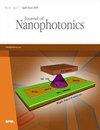Analysis of the Purcell effect of plasmonic supercrystal films and nanocavities made by close-packed metallic nanoparticles
IF 1.1
4区 物理与天体物理
Q4 NANOSCIENCE & NANOTECHNOLOGY
引用次数: 0
Abstract
Plasmonic supercrystals (PSCs) made by colloidal self-assembly metallic nanoparticles can be regarded as a special kind of optical metamaterials with intriguing properties, such as engineered refractive indices and densely distributed near field “hot spots.” Analysis of the Purcell effect of PSCs is crucial for many applications related to light-emission processes, such as surface-enhanced Raman scattering and spontaneous emission enhancement. We present a detailed theoretical and numerical study on the Purcell effect of films and nanocavities made of PSCs. We first demonstrate that the spectral response of the Purcell effect of a monolayer PSC can be basically divided into the surface plasmon polariton regime, the collective plasmon (CP) regime, and the dielectric regime. In particular, we reveal that the resonances in the CP regime have rich fine structures of near fields, resulting in a strong dependence of the Purcell effect on the position and polarization of emitters. We further show that nanocavities consist of PSCs that sustain Mie-like electric and magnetic multipolar resonances that can be utilized to enhance the Purcell effect in the near-infrared band. Our results are helpful for understanding the light–matter interactions at nanoscale and may promote applications of PSCs in light-emission engineering.由紧密堆积的金属纳米粒子制成的等离子超晶薄膜和纳米腔体的珀塞尔效应分析
由胶体自组装金属纳米粒子制成的等离子体超晶体(PSCs)可被视为一种特殊的光学超材料,具有引人入胜的特性,如工程折射率和密集分布的近场 "热点"。分析 PSCs 的珀塞尔效应对于许多与光发射过程有关的应用至关重要,例如表面增强拉曼散射和自发辐射增强。我们对 PSCs 薄膜和纳米腔体的珀塞尔效应进行了详细的理论和数值研究。我们首先证明了单层 PSC 的珀塞尔效应光谱响应基本上可分为表面等离子体极化子机制、集合等离子体(CP)机制和介电机制。我们特别揭示了 CP 体系中的共振具有丰富的近场精细结构,从而导致珀塞尔效应与发射器的位置和极化具有很强的相关性。我们进一步表明,纳米腔体由 PSC 组成,PSC 可维持类似米氏的电和磁多极共振,可用于增强近红外波段的珀塞尔效应。我们的研究结果有助于理解纳米尺度的光-物质相互作用,并可促进 PSCs 在光发射工程中的应用。
本文章由计算机程序翻译,如有差异,请以英文原文为准。
求助全文
约1分钟内获得全文
求助全文
来源期刊

Journal of Nanophotonics
工程技术-光学
CiteScore
2.60
自引率
6.70%
发文量
42
审稿时长
3 months
期刊介绍:
The Journal of Nanophotonics publishes peer-reviewed papers focusing on the fabrication and application of nanostructures that facilitate the generation, propagation, manipulation, and detection of light from the infrared to the ultraviolet regimes.
 求助内容:
求助内容: 应助结果提醒方式:
应助结果提醒方式:


